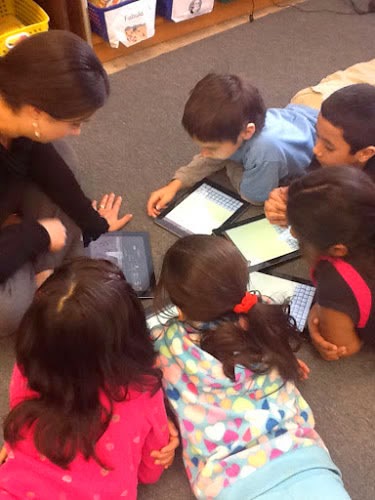The Unquiet Classroom: Technology Integration and ELLs

What images come to mind when you imagine a classroom filled with kids using technology?
The Unquiet Classroom: Ashley Coblentz & Jackie Moreno
A language rich environment or a silent room with students staring at screens? It seems like there is a divide around this issue in the teaching world right now. Recently, we heard a leader in the biliteracy community speak dismissively about providing ELLs with access to technology. Common misconceptions about one-to-one technology initiatives and ELLs include:
- Kids lose interpersonal skills
- ELLs do not get enough opportunities to produce oral language
- Districts purchase devices in a largely unsuccessful attempt to replace good teaching
Before we started using technology with our students, we had similar reservations. If you also have these concerns, rather, imagine:
- Instead of writing a book report, students become movie producers, bringing excitement to project-based learning
- Instead of just “publishing” one paper version of a story during writing workshop, students publish ebooks, accessible to hundreds of people, sending digital copies to all of their friends, teachers and family members, creating a digital library
- Instead of writing a simple reader-response journal entry, students compose original songs in GarageBand to demonstrate learning
Technology integration has helped us become more effective when it comes to formative assessment, meaningful project-based learning, providing language learners with appropriate scaffolds and giving students exciting opportunities to write for authentic purposes.
Our hope is that by sharing how teachers and students are using devices as tools for transformative learning, members of the ELL educational community concerned about potential misuse of of technology will see what is possible. At this point, we can’t imagine not advocating for other ELLs to have similar opportunities. If you are an ELL teacher wanting to make a case to your school’s administration or colleagues about the powerful ways technology integration can support language learners’ academic success, here are some talking points regarding technology integration:
- It promotes student collaboration
- When used purposefully technology integration increases student talk, providing opportunities for oral language development and more accurate assessment
- Teachers are able to provide more interactive, graphic and sensory language supports
- Student creativity is cultivated through project based learning
Ultimately, these ways to support ELLs’ academic success can be realized on a whole new level when technology integration becomes part of the story.
To see some concrete examples of how technology integration lives and breathes in a bilingual classroom, check out our students’ presentation to our district’s Board of Education prior to a 6-1 vote to pass a $27 million tech plan:
Tools and ideas to transform education. Sign up below.
cross posted at widaatwcer.blogspot.com
Read more by educators Ashley Coblentz and Jackie Moreno at widaatwcer.blogspot.com.
